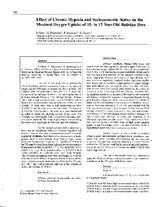Effect of chronic hypoxia and socioeconomic status on the maximal oxygen uptake of 10- to 12-year-old Bolivian boys

View/
Date
1994Author
Obert, P
Falgairette, G
Spielvogel, H
Cáceres, E
Metadata
Show full item recordAbstract
Abstract.
The aim of this study was to analyze the effect of altitude and socioeconomic status on the maximal oxygen uptake (VO₂max) of prepubertal Bolivian boys. The subjects were 143 prepubertal boys (10 to 11.5 years old) living in La Paz (altitude 3600 m, n = 67) and Santa Cruz de la Sierra (altitude 420 m, n = 76). At high altitude, 23 boys were from a high socioeconomic status (HAHSES) and 44 from a low socioeconomic background (HALSES). At low altitude, 29 boys were from a high socioeconomic level (LAHSES) and 47 from a low socioeconomic background (LALSES). Anthropometric characteristics were determined in order to assess the physical growth of the boys. The VO₂max was determined from a progressive maximal exercise (direct method). The subjects performed this test using the same cycle ergometer at both high and low altitudes. For the overall anthropometric parameters, there was no significant difference between highland and lowland boys of the same socioeconomic status. However, regardless of altitude, boys from a low socioeconomic background were 2 years behind those from a high socioeconomic background. There was no significant difference for VO₂max between boys from high and low socioeconomic backgrounds at HA (HAHSES: 37.2 ± 5.6; HALSES: 38.9 ± 6.4ml.min-1 .kg-1 body weight) and at LA (LAHSES: 42.6 ± 5.4; LALSES: 43.1 ± 4.9 ml . min-1 . kg-1 body weight). The VO₂max of highland boys was, on average, 11% lower than that of lowland boys. It appears, therefore, that a difference in socioeconomic status has no effect on the VO₂max (ml. min-1 . kg-1) of prepubertal children at low altitude as well as the altitude of 3600 m.
